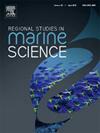Spatial changes of macrobenthic polychaete assemblages from the southern Mexican Pacific shelf: diversity patterns and feeding guilds composition
IF 2.1
4区 环境科学与生态学
Q3 ECOLOGY
引用次数: 0
Abstract
Polychaetes account for most of the macrobenthic species found in soft bottoms, but in the Tropical Eastern Pacific, and particularly in the southern Mexican Pacific shelf, their composition and diversity patterns are very poorly known. So, the aim of this study was to analyze how the polychaetes are distributed in relation to the environmental variables across the continental shelf in that area, and to classify their assemblages as defined by the species present and their variations. For this purpose, we examined 3741 individuals of 82 species, collected there at 38 stations between 42–109 m depth. Using univariate and multivariate statistical approaches, we found that depth was the main structuring variable, to separate the faunal assemblages, with the sediment texture as secondary, but also statistically important. The distribution of the assemblages and the largest changes in diversity and variety of feeding modes were highly linked to shelf levels. The assemblage Paraprionospio pinnata-Magelona marianae (PpMm) was defined for the inner shelf, with the highest diversity and dominated by surface deposit feeder species. In the middle and outer shelves, the diversity values decreased, and the motile carnivore species gradually replaced the detritivores, determining the presence of the assemblages Linopherus kristiani-P. pinnata (PpLk) and L. kristiani (Lk), respectively. The sandy bottoms, well oxygenated and with low concentrations of nutrients from the inner shelf, correlated well with the rich assemblage PpMm, while in the deeper zones with muddy bottoms, higher in nutrients and poorly oxygenated, the less diverse assemblages PpLk and Lk occurred. Knowing how the polychaete assemblages change with depth and sediment composition in this poorly explored marine region, can be useful to develop future research, by examining their occurrence on distinct habitats and to monitor long-term faunal and environmental changes.
南墨西哥太平洋陆架大型底栖多毛类群落的空间变化:多样性格局和摄食行会组成
在软底区发现的大型底栖动物中,多毛类占大多数,但在热带东太平洋,特别是在墨西哥太平洋南部大陆架,人们对它们的组成和多样性模式知之甚少。因此,本研究的目的是分析多毛体在该地区大陆架上的分布情况与环境变量的关系,并根据现有物种及其变化对其组合进行分类。为此,我们在42 ~ 109 m深度的38个站点采集了82个物种的3741个个体。采用单变量和多变量统计方法,我们发现深度是区分动物群组合的主要结构变量,沉积物质地次之,但在统计上也很重要。群落的分布、多样性和摄食方式的最大变化与陆架高度相关。内陆架为Paraprionospio pinnata-Magelona marianae (PpMm)组合,多样性最高,以表层沉积物取食物种为主。在中、外陆架,多样性值逐渐下降,活动食肉动物逐渐取代了腐食动物,确定了linophherus kristiani-P组合的存在。分别为pinnata (PpLk)和L. kristiani (Lk)。含氧较好、内陆架营养物浓度较低的砂质底部与丰富的PpMm组合具有良好的相关性,而在含氧较低、营养物含量较高的泥质底部,PpLk和Lk组合的多样性较低。了解多毛类组合是如何随着深度和沉积物组成的变化而变化的,可以通过检查它们在不同栖息地的出现,并监测长期的动物和环境变化,从而有助于开展未来的研究。
本文章由计算机程序翻译,如有差异,请以英文原文为准。
求助全文
约1分钟内获得全文
求助全文
来源期刊

Regional Studies in Marine Science
Agricultural and Biological Sciences-Ecology, Evolution, Behavior and Systematics
CiteScore
3.90
自引率
4.80%
发文量
336
审稿时长
69 days
期刊介绍:
REGIONAL STUDIES IN MARINE SCIENCE will publish scientifically sound papers on regional aspects of maritime and marine resources in estuaries, coastal zones, continental shelf, the seas and oceans.
 求助内容:
求助内容: 应助结果提醒方式:
应助结果提醒方式:


